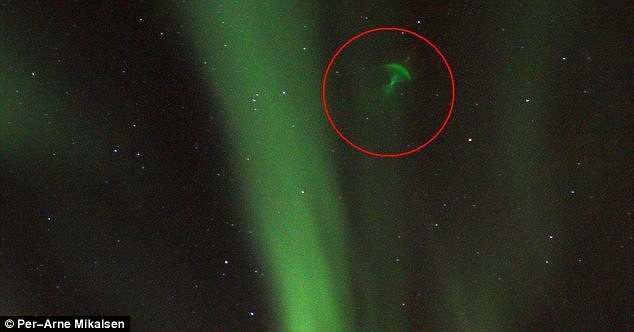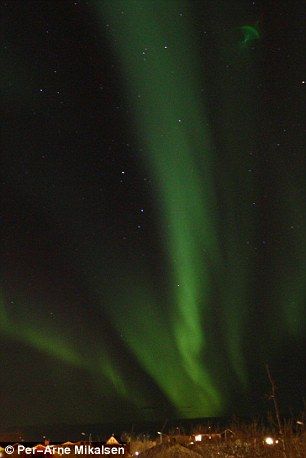
If proven it will be the first known case of a satellite reflecting the Northern Lights.
The mysterious phenomenon was photographed last week by amateur photographer Per-Arne Milkalsen over Andenesm, Norway.
The photographer became fascinated with aurorae after working at a rocket launch site in the far north of Norway for 25 years. The northern lights are often visible here because it is so close to the North Pole.
Aurorae are caused by the interaction of the solar wind with Earth's magnetic field and so are particularly prevalent at the poles where the magnetic forces are strongest.
Mr Mikalsen told the Mail Online: 'I have never seen an object like this before, and I am eager to find an explanation to the phenomenon.'
The photographer first assumed the odd optical effect was a spot on his camera lens. But after he posted his photographs on Spaceweather.com he was inundated with emails from interested experts from around the world.
Lead scientist Truls Lynn Hansen from Tromsø Geophysical Observatory said he doubted the picture, taken on January 20, was due to a simple camera fault.
He told the Mail Online: 'The "phenomenon" has the same greenish colour as the Northern Lights. That means the Northern Lights is the source of light causing the strange phenomenon.'

In this way it would act like an 'iridium flare.' The flares are created by sunlight reflecting off iridium satellites. They appear as bright white flashes in the sky.
One problem with Mr Hansen's theory is that the light intensity from the Northern Lights is 100,000 times weaker than the sunlight. But Mr Hansen said this did not exclude the satellite reflection hypothesis.
'The intensity of an intense aurora is not far from the intensity of moonlight,' he said.
'And the (jellyfish) phenomenon is also quite weak. Apparently many orders of magnitude down compared to the solar iridium flares.'
Pal Brekke, senior adviser, at the Norwegian Space Centre, told the Mail Online: 'A reflection from streetlight would be the most straightforward explanation.
'But why is it green? One should think it would be white or yellow if it was a reflection from the streetlight.
'So while I am not yet fully convinced it was a satellite - one cannot rule this out.'



If this is the reflection of a satellite. Why it has to be seen at an empty place next to my house ??
The same shaped lights appeared twice captured by me..Take a look at this..
[Link]